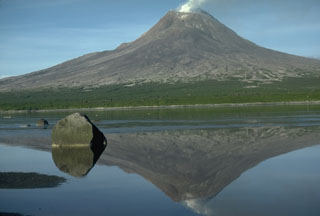Report on Augustine (United States) — February 1976
Natural Science Event Bulletin, vol. 1, no. 5 (February 1976)
Managing Editor: David Squires.
Augustine (United States) Explosive activity; heavy ashfall in Homer; new lava dome
Please cite this report as:
Global Volcanism Program, 1976. Report on Augustine (United States) (Squires, D., ed.). Natural Science Event Bulletin, 1:5. Smithsonian Institution. https://doi.org/10.5479/si.GVP.NSEB197602-313010
Augustine
United States
59.3626°N, 153.435°W; summit elev. 1218 m
All times are local (unless otherwise noted)
Explosive activity resumed at 0442 on 6 February, as documented by seismic and infrasonic signals, and by another ashfall along the NW margin of the Kenai Peninsula. In the morning a muddy rain fell in Kenai and Ninilchik along with considerable ash. Another eruption occurred at 1230, and a Wien Airlines pilot reported the top of the cloud at 7.5-9 km. At 1800 on 6 February a blizzard-like ash storm occurred at Homer, becoming so dark that vehicular traffic stopped. This fall of very fine tan-colored ash was the heaviest that Homer had received during the eruption sequence.
The volcano erupted almost continuously until 16 February, when the activity primarily returned to steam explosions. During that period there were an abundance of seismic and infrasonic signals. Cloud tops commonly reached heights of 3-4.5 km. The Geophysical Institute made aircraft observations almost daily 8-18 February except the 10th and 14th. The pilot observed that ash was erupted until 16 February.
Geophysical Institute scientists visited Augustine on 18 February and observed occasional ash puffs but not the continuous outpouring of ash that had occurred earlier. During the period of continuous strong ash activity there had also been new nuées ardentes and the NE part of the island was again enlarged.
Temperatures of 604°C were measured in the new nuée ardente, which overlay one from the first phase. This temperature was reached at a depth of 2 m, away from fumaroles. Ambient temperature was 0°C. A new lava dome was extruded, possibly on 11-12 February, and the top was about 250 m above the base. From 18 February to the end of the month the volcano was fairly quiet.
Geological Summary. Augustine volcano, rising above Kamishak Bay in the southern Cook Inlet about 290 km SW of Anchorage, is the most active volcano of the eastern Aleutian arc. It consists of a complex of overlapping summit lava domes surrounded by an apron of volcaniclastic debris that descends to the sea on all sides. Few lava flows are exposed; the flanks consist mainly of debris-avalanche and pyroclastic-flow deposits formed by repeated collapse and regrowth of the summit. The latest episode of edifice collapse occurred during Augustine's large 1883 eruption; subsequent dome growth has restored the edifice to a height comparable to that prior to 1883. The oldest dated volcanic rocks on Augustine are more than 40,000 years old. At least 11 large debris avalanches have reached the sea during the past 1,800-2,000 years, and five major pumiceous tephras have been erupted during this interval. Recorded eruptions have typically consisted of explosive activity with emplacement of pumiceous pyroclastic-flow deposits followed by lava dome extrusion with associated block-and-ash flows.
Information Contacts: J. Kienle, Univ. of Alaska.

